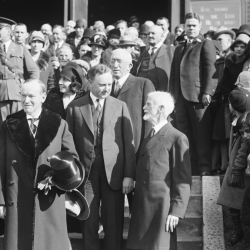Two years ago we were witnessing the quickest pivot in commercial history, as brands and businesses attempted to work out in record time how to talk to their customers in the sudden and uncharted territory of a modern global pandemic.
But what soon became apparent was that internal communications needed just as much attention as teams went remote overnight. And while people pulled out all the stops because circumstances demanded it, many have subsequently appreciated just how powerful an enhanced level of internal communications is for any business.
Gone are the days of the global CEO addressing the whole company from a town hall meeting streamed live regardless of the local time. No more death by Powerpoint for a four hour market update presentation. And down with the rambling 5,000 word missive from the CEO that drops in every employee’s inbox at 5pm on a Friday.
As an events company we have seen a growing demand from our clients — existing and new — for an event style internal communications offering. But what are the key considerations of every leader before deciding on the most effective format for their business?
Who is your audience and what are you telling them?
Ensure you are clear on who will be tuning in from the outset. Is it your senior management team or the entire international workforce? Maybe you’re speaking just to the board or to your investors. Or perhaps the purpose of the comms is a team bonding session, or something for new starters.
If you don’t speak to people in the right tone, with the right content, they will either tune out or be put off, which will be more damaging than if you hadn’t undertaken the comms in the first place.
Don’t be afraid to create different pieces of content for different audiences, or to represent gear shifts in the tone of the session. A live speech or a piece to camera from the CEO to cover the serious issues such as sales results or market reflections, then a sizzle reel set to upbeat music that celebrates business success or positive change will each command the appropriate level of focus from the audience.
What medium should you use and who should front it?
The events industry reinvented itself in lockdown to become an entirely virtual concept, from online gigs to immersive experiences and live streamed content in the style of a TV show. And we are now seeing growing demand from businesses who want to either continue this style of events — at least in part — or apply the same principles to their own company’s events.
The huge advantage of a virtual event is that the scope for creativity is unlimited. Pre-records, audience participation and opportunities to interact all add a little extra something and help keep audiences switched on and engaged.
Hybrid events are the most obvious route, as they work as a live event for people in the room but can be watched online — either live or streamed later. This is particularly pertinent if you are working across multiple time zones: colleagues on the other side of the world will thank you for not asking them to stay up till midnight for a company conference.
And don’t assume the CEO or MD is the only person who can front your internal comms. Bringing in different names and faces will keep things interesting, and strike a more collaborative, inclusive note. Depending on the style of event you go for (and the budget) maybe consider bringing in someone from outside the company to front a segment. A key client, perhaps, or even a minor celebrity? Spicing up the running order all helps to keep people’s attention!
Prepare like it’s a pitch
From early on in the planning process it’s important that any company that is genuinely committed to creating a professional, memorable internal comms event has the experts on hand. Many events businesses like ours are geared up for exactly this type of content-focused live or hybrid event and can advise on the best course of action depending on the desired outcome.
Just as you wouldn’t rock up to a pitch without proper planning and hope you can wing it on the day, you should approach an internal event with the appropriate planning. A script, a producer and director, a number of dry runs and a decent amount of crisis planning are all must-haves.
Ensure whoever you ask to present is comfortable in front of the camera. Pre-records are useful if presenters are prone to nerves, or likely to need numerous takes, and dress rehearsals are absolutely critical as even the most confident person in the planning process can freeze when the red light is on. Finding these crucial details out on the day will be nothing short of a disaster.
Internal communications have changed, and those who have got on board with that are embracing the new model. Finally, leaders are applying the same attention to detail as they would for their clients. And so they should — an engaged workforce that is aligned with the company’s plans, purpose and ambitions is an invaluable asset.
Featured image: Halt and Catch Fire / AMC





























